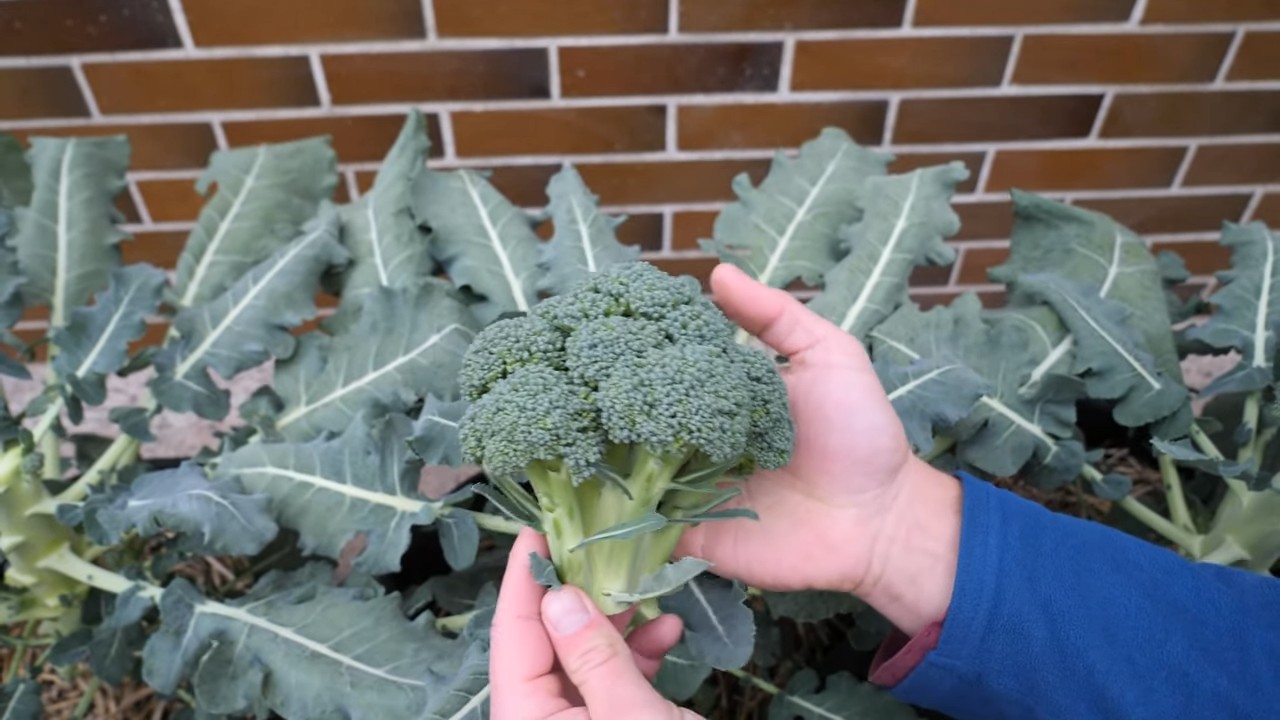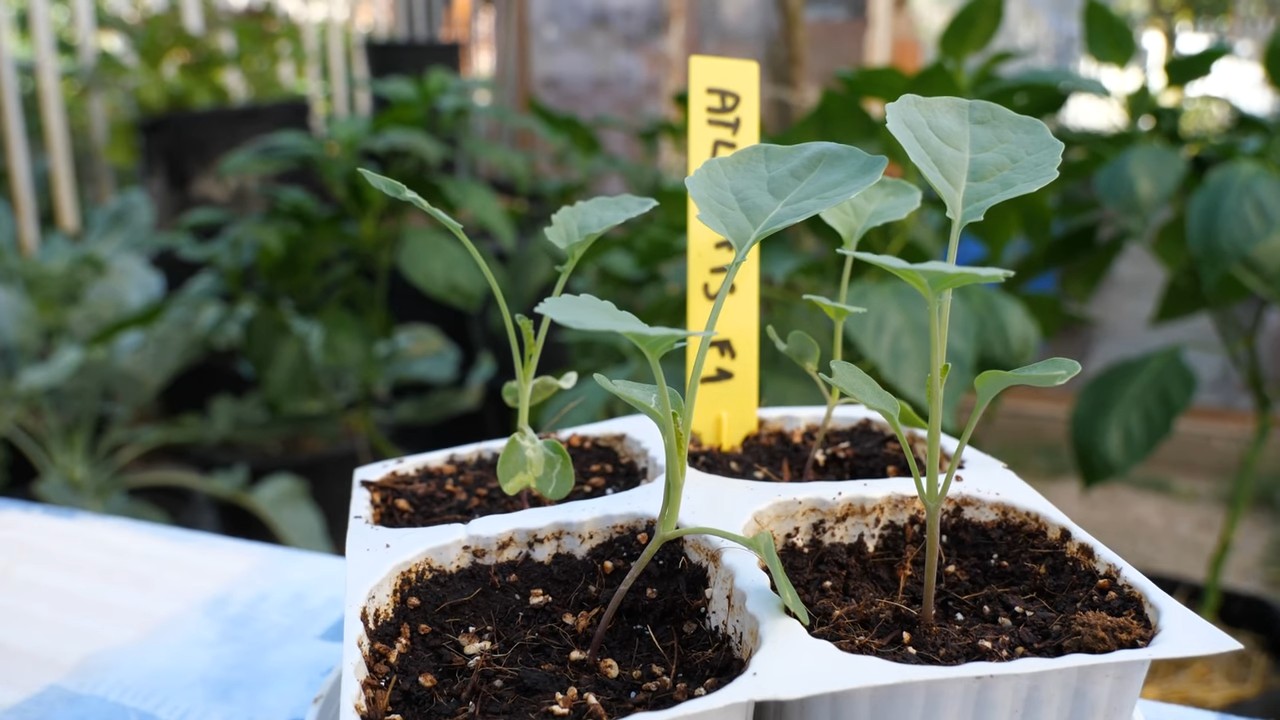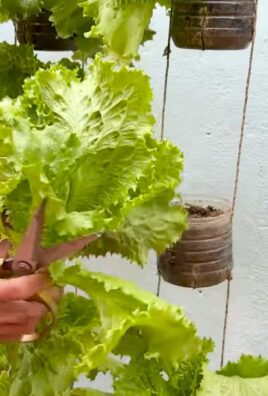Growing Broccoli in Pots: Imagine harvesting fresh, vibrant broccoli right from your own patio! It’s easier than you think, and this guide is your secret weapon to achieving just that. Forget those expensive grocery store prices and questionable freshness – we’re diving headfirst into the rewarding world of container gardening.
Broccoli, a nutritional powerhouse, has a rich history dating back to ancient Rome, where it was prized for its health benefits and unique flavor. Over centuries, it has become a staple in cuisines worldwide. But did you know you don’t need acres of land to enjoy this superfood?
In today’s busy world, many of us lack the space for a traditional garden. That’s where the magic of growing broccoli in pots comes in! This DIY guide will provide you with simple, step-by-step instructions and clever hacks to successfully cultivate broccoli, even if you’re a complete beginner. We’ll cover everything from choosing the right pot and soil to preventing pests and harvesting your bounty. So, let’s get our hands dirty and unlock the secrets to a thriving container broccoli garden!

Growing Broccoli in Pots: A Complete DIY Guide
Hey there, fellow gardening enthusiasts! I’m so excited to share my tried-and-true method for growing broccoli in pots. It’s easier than you might think, and the satisfaction of harvesting your own homegrown broccoli is simply unbeatable. Let’s dive in!
Choosing the Right Broccoli Variety
First things first, not all broccoli varieties are created equal when it comes to container gardening. You’ll want to opt for compact or dwarf varieties that won’t outgrow their pots. Here are a few of my favorites:
* ‘Premium Crop’: A reliable and productive variety that produces large, tight heads.
* ‘Waltham 29’: A classic heirloom variety known for its cold hardiness and delicious flavor.
* ‘Green Magic’: An early-maturing variety that’s perfect for shorter growing seasons.
* ‘De Cicco’: Another heirloom option that produces a main head followed by numerous side shoots, extending your harvest.
Gathering Your Supplies
Before we get our hands dirty, let’s make sure we have everything we need. Here’s a checklist:
* Broccoli seeds or seedlings: Choose your preferred variety and source them from a reputable supplier.
* Large pots: Aim for pots that are at least 12-18 inches in diameter and depth. Broccoli needs plenty of room for its roots to develop.
* High-quality potting mix: Avoid using garden soil, as it can compact in containers. Opt for a well-draining potting mix that’s rich in organic matter.
* Slow-release fertilizer: This will provide your broccoli plants with a steady supply of nutrients throughout the growing season.
* Watering can or hose: Essential for keeping your broccoli plants hydrated.
* Trowel: For transplanting seedlings.
* Gardening gloves: To protect your hands.
* Optional: Row covers or netting to protect against pests like cabbage moths and aphids.
Planting Your Broccoli
Now for the fun part! Whether you’re starting from seeds or transplanting seedlings, the planting process is relatively straightforward.
Starting from Seeds:
1. Sow your seeds indoors: About 6-8 weeks before the last expected frost, sow your broccoli seeds in seed trays or small pots filled with potting mix. Plant the seeds about 1/4 inch deep.
2. Provide warmth and light: Keep the soil consistently moist and provide warmth (around 70-75°F) for germination. A heat mat can be helpful. Once the seedlings emerge, provide them with plenty of light, either from a sunny window or a grow light.
3. Harden off the seedlings: Before transplanting your seedlings outdoors, you’ll need to harden them off. This involves gradually exposing them to outdoor conditions over a period of 7-10 days. Start by placing them in a sheltered spot for a few hours each day, gradually increasing the amount of time they spend outdoors.
4. Transplant into pots: Once the seedlings are hardened off and the danger of frost has passed, you can transplant them into your large pots. Fill each pot with potting mix, leaving a few inches of space at the top. Dig a hole large enough to accommodate the seedling’s root ball and gently place the seedling in the hole. Backfill with potting mix and water thoroughly.
Transplanting Seedlings:
1. Prepare your pots: Fill your large pots with potting mix, leaving a few inches of space at the top.
2. Gently remove the seedlings from their containers: Be careful not to damage the roots. If the seedlings are root-bound, gently loosen the roots before planting.
3. Plant the seedlings: Dig a hole in the potting mix large enough to accommodate the seedling’s root ball. Place the seedling in the hole and backfill with potting mix. Water thoroughly.
4. Add slow-release fertilizer: Sprinkle a slow-release fertilizer around the base of the plant, following the instructions on the package.
Caring for Your Broccoli Plants
Once your broccoli plants are in their pots, it’s time to provide them with the care they need to thrive.
1. Watering: Broccoli needs consistent moisture, especially during hot weather. Water deeply whenever the top inch of soil feels dry to the touch. Avoid overhead watering, as this can lead to fungal diseases.
2. Fertilizing: In addition to the slow-release fertilizer you added at planting time, you may need to supplement with liquid fertilizer every few weeks. Choose a fertilizer that’s high in nitrogen, which is essential for leafy growth.
3. Sunlight: Broccoli needs at least 6 hours of sunlight per day. Place your pots in a sunny location where they’ll receive plenty of light.
4. Pest control: Broccoli is susceptible to a variety of pests, including cabbage moths, aphids, and flea beetles. Inspect your plants regularly for signs of infestation and take action promptly. You can use insecticidal soap, neem oil, or row covers to control pests.
5. Weed control: Keep your pots free of weeds, as they can compete with your broccoli plants for nutrients and water. Hand-pull any weeds that appear.
6. Support: As your broccoli plants grow, they may become top-heavy. If necessary, provide support with stakes or cages to prevent them from falling over.
Harvesting Your Broccoli
The moment you’ve been waiting for! Harvesting your homegrown broccoli is incredibly rewarding.
1. Harvest when the heads are firm and tight: The ideal time to harvest broccoli is when the heads are fully developed but the florets are still tightly closed. If the florets start to open and turn yellow, it’s a sign that the broccoli is past its prime.
2. Cut the main head: Use a sharp knife to cut the main head of broccoli from the plant, leaving a few inches of stem.
3. Encourage side shoots: After you harvest the main head, the plant will produce side shoots. These smaller heads of broccoli can be harvested over a period of several weeks, extending your harvest.
4. Store your broccoli: Freshly harvested broccoli can be stored in the refrigerator for up to a week. To keep it fresh, wrap it in a damp paper towel and place it in a plastic bag.
Troubleshooting Common Problems
Even with the best care, you may encounter some problems while growing broccoli in pots. Here are a few common issues and how to address them:
* Yellowing leaves: This can be a sign of nutrient deficiency, overwatering, or underwatering. Check the soil moisture and fertilize if necessary.
* Small heads: This can be caused by insufficient sunlight, poor soil, or lack of fertilizer. Make sure your plants are getting enough sunlight and provide them with adequate nutrients.
* Pest infestations: As mentioned earlier, broccoli is susceptible to a variety of pests. Inspect your plants regularly and take action promptly to control pests.
* Bolting: Bolting occurs when broccoli plants flower prematurely, usually due to hot weather. To prevent bolting, choose heat-tolerant varieties and provide shade during the hottest part of the day.
Extra Tips for Success
Here are a few extra tips to help you grow the best broccoli possible in pots:
* Choose the right pot size: As I mentioned earlier, broccoli needs plenty of room for its roots to develop. Make sure you choose pots that are at least 12-18 inches in diameter and depth.
* Use high-quality potting mix: Don’t skimp on the potting mix! A well-draining potting mix that’s rich in organic matter will provide your broccoli plants with the nutrients they need to thrive.
* Water consistently: Broccoli needs consistent moisture, especially during hot weather. Water deeply whenever the top inch of soil feels dry to the touch.
* Fertilize regularly: Broccoli is a heavy feeder, so it’s important to fertilize regularly. Use a slow-release fertilizer at planting time and supplement with liquid fertilizer every few weeks.
* Protect against pests: Broccoli is susceptible to a variety of pests, so it’s important to take steps to protect your plants. Use row covers or netting to prevent pests from reaching your plants.
* Rotate your crops: To prevent soilborne diseases, avoid planting broccoli in the same spot year after year. Rotate your crops to different areas of your garden.
Growing broccoli in pots is a rewarding experience that allows you to enjoy fresh, homegrown vegetables even if you don’t have a large garden. With a little bit of care and attention, you can harvest delicious broccoli right from your own patio or balcony. Happy gardening!

Conclusion
So, there you have it! Growing broccoli in pots is not only achievable, but it can be a deeply rewarding experience, bringing the farm-to-table freshness right to your doorstep, balcony, or patio. We’ve walked through the entire process, from selecting the right pot and soil to nurturing your broccoli plants and harvesting those delicious, nutrient-packed heads.
Why is this DIY trick a must-try? Because it empowers you to take control of your food source, ensuring you’re consuming fresh, organic broccoli free from harmful pesticides. It’s also a fantastic way to connect with nature, learn about the growing process, and enjoy the satisfaction of harvesting something you’ve nurtured from seed (or seedling) to table. Plus, it’s a space-saving solution for those with limited garden space. Imagine the pride you’ll feel serving up a broccoli dish made with ingredients you grew yourself!
But the fun doesn’t stop there! Feel free to experiment with different varieties of broccoli. Romanesco broccoli, with its stunning fractal patterns, is a visual delight and offers a slightly nuttier flavor. Or, try sprouting broccoli, which produces smaller, more tender florets over a longer period. You can also explore companion planting by adding herbs like rosemary or thyme to your pot, which can help deter pests and enhance the flavor of your broccoli. Consider adding marigolds around the base of your broccoli plants; they are known to repel nematodes and other soil pests.
Don’t be afraid to adjust the watering schedule based on your local climate and the specific needs of your plants. Remember to check the soil moisture regularly and adjust accordingly. If you live in a particularly hot climate, you might need to water more frequently. Conversely, if you live in a cooler, more humid climate, you might need to water less often.
The key to successful **growing broccoli in pots** lies in consistent care and attention. Regularly check your plants for pests and diseases, and take action promptly if you notice any problems. A little bit of preventative care can go a long way in ensuring a bountiful harvest.
We wholeheartedly encourage you to give this DIY project a try. It’s a fantastic way to add fresh, healthy vegetables to your diet, connect with nature, and learn a new skill. And most importantly, we want to hear about your experience! Share your photos, tips, and challenges in the comments below. Let’s create a community of pot-grown broccoli enthusiasts and learn from each other. What varieties did you try? What challenges did you face, and how did you overcome them? Your insights could be invaluable to other aspiring broccoli growers. Happy gardening!
Frequently Asked Questions (FAQ)
1. What is the best size pot for growing broccoli?
The ideal pot size for growing broccoli is at least 12 inches in diameter and 12 inches deep, but larger is generally better. A 5-gallon pot is a good starting point, but a 10-gallon pot will provide even more room for the roots to develop, leading to a healthier and more productive plant. Remember that broccoli plants can get quite large, so providing ample space for their root systems is crucial for their overall health and yield. If you’re planning on growing multiple broccoli plants in the same container, opt for a larger container, such as a half-barrel planter.
2. What type of soil is best for growing broccoli in pots?
Broccoli thrives in well-draining, nutrient-rich soil. A good quality potting mix specifically formulated for vegetables is ideal. Avoid using garden soil, as it can be too heavy and compact in pots, hindering drainage and root development. You can also amend your potting mix with compost or aged manure to boost its nutrient content. Aim for a soil pH between 6.0 and 7.0 for optimal broccoli growth. Consider adding perlite or vermiculite to your potting mix to improve drainage and aeration.
3. How often should I water my potted broccoli plants?
Water your potted broccoli plants regularly, keeping the soil consistently moist but not waterlogged. Check the soil moisture level daily by sticking your finger about an inch into the soil. If the soil feels dry to the touch, it’s time to water. Water deeply, allowing the water to drain out of the bottom of the pot. Avoid overhead watering, as this can increase the risk of fungal diseases. During hot, dry weather, you may need to water your plants more frequently. Mulching around the base of the plants can help retain moisture in the soil.
4. How much sunlight do broccoli plants need?
Broccoli plants need at least 6 hours of direct sunlight per day to thrive. Choose a location that receives plenty of sunlight throughout the day. If you live in a particularly hot climate, providing some afternoon shade can help prevent the plants from overheating. If you don’t have a sunny spot, you can supplement with grow lights. Rotate your pots regularly to ensure that all sides of the plants receive adequate sunlight.
5. What are some common pests and diseases that affect broccoli plants, and how can I control them?
Common pests that affect broccoli plants include aphids, cabbage worms, and flea beetles. You can control these pests by handpicking them off the plants, using insecticidal soap, or applying Bacillus thuringiensis (Bt), a natural bacterium that is effective against cabbage worms. Common diseases include clubroot, black rot, and downy mildew. To prevent these diseases, ensure good air circulation, avoid overhead watering, and use disease-resistant varieties. If you notice signs of disease, remove the affected leaves and treat the plants with a fungicide. Regularly inspect your plants for signs of pests and diseases, and take action promptly to prevent them from spreading.
6. When is the best time to harvest broccoli?
Harvest broccoli when the heads are firm, tight, and a deep green color. The individual florets should be tightly closed. If the florets start to open and turn yellow, it’s a sign that the broccoli is overripe. Cut the main head off with a sharp knife, leaving a few inches of stem. Side shoots will often develop after the main head is harvested, providing you with additional broccoli florets over a longer period. Harvest these side shoots when they reach a desirable size.
7. Can I grow broccoli in pots indoors?
While it’s possible to grow broccoli in pots indoors, it can be challenging to provide the plants with the amount of sunlight they need. If you want to try growing broccoli indoors, you’ll need to supplement with strong grow lights. Choose a compact variety of broccoli that is well-suited for container gardening. Ensure good air circulation and monitor the plants closely for pests and diseases.
8. How do I fertilize my potted broccoli plants?
Fertilize your potted broccoli plants regularly with a balanced fertilizer, such as a 10-10-10 or 20-20-20 formula. Follow the instructions on the fertilizer package for application rates. You can also use a liquid fertilizer, such as fish emulsion or seaweed extract, to provide your plants with a boost of nutrients. Fertilize your plants every 2-3 weeks, starting when they are about 4-6 inches tall. Avoid over-fertilizing, as this can lead to excessive foliage growth and reduced head production.
9. Can I save seeds from my broccoli plants?
Saving seeds from broccoli plants can be challenging, as broccoli is a biennial plant, meaning it typically takes two years to produce seeds. Additionally, broccoli is often cross-pollinated, so the seeds you collect may not produce plants that are true to type. If you want to try saving seeds, choose an open-pollinated variety of broccoli and allow the plants to flower and produce seed pods. Collect the seed pods when they are dry and brown, and store the seeds in a cool, dry place.
10. What are some good companion plants for broccoli?
Good companion plants for broccoli include herbs like rosemary, thyme, and sage, which can help deter pests. Marigolds are also effective at repelling nematodes and other soil pests. Other beneficial companion plants include onions, garlic, and dill. Avoid planting broccoli near members of the nightshade family, such as tomatoes, peppers, and eggplants, as they can compete for nutrients and attract similar pests.




Leave a Comment